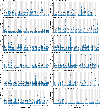Characterizing the Shared Genetic Underpinnings of Schizophrenia and Cardiovascular Disease Risk Factors
- PMID: 37752828
- PMCID: PMC11780279
- DOI: 10.1176/appi.ajp.20220660
Characterizing the Shared Genetic Underpinnings of Schizophrenia and Cardiovascular Disease Risk Factors
Abstract
Objective: Schizophrenia is associated with increased risk of cardiovascular disease (CVD), although there is variation in risk among individuals. There are indications of shared genetic etiology between schizophrenia and CVD, but the nature of the overlap remains unclear. The aim of this study was to fill this gap in knowledge.
Methods: Overlapping genetic architectures between schizophrenia and CVD risk factors were assessed by analyzing recent genome-wide association study (GWAS) results. The bivariate causal mixture model (MiXeR) was applied to estimate the number of shared variants and the conjunctional false discovery rate (conjFDR) approach was used to pinpoint specific shared loci.
Results: Extensive genetic overlap was found between schizophrenia and CVD risk factors, particularly smoking initiation (N=8.6K variants) and body mass index (BMI) (N=8.1K variants). Several specific shared loci were detected between schizophrenia and BMI (N=304), waist-to-hip ratio (N=193), smoking initiation (N=293), systolic (N=294) and diastolic (N=259) blood pressure, type 2 diabetes (N=147), lipids (N=471), and coronary artery disease (N=35). The schizophrenia risk loci shared with smoking initiation had mainly concordant effect directions, and the risk loci shared with BMI had mainly opposite effect directions. The overlapping loci with lipids, blood pressure, waist-to-hip ratio, type 2 diabetes, and coronary artery disease had mixed effect directions. Functional analyses implicated mapped genes that are expressed in brain tissue and immune cells.
Conclusions: These findings indicate a genetic propensity to smoking and a reduced genetic risk of obesity among individuals with schizophrenia. The bidirectional effects of the shared loci with the other CVD risk factors may imply differences in genetic liability to CVD across schizophrenia subgroups, possibly underlying the variation in CVD comorbidity.
Keywords: Body Mass Index; Cardiovascular Disease; Genetic Overlap; Lifestyle; Schizophrenia Spectrum and Other Psychotic Disorders; Smoking.
Figures


Comment in
-
Dissecting the Genetic Relationship Between Schizophrenia and Cardiovascular Disease.Am J Psychiatry. 2023 Nov 1;180(11):785-786. doi: 10.1176/appi.ajp.20230714. Am J Psychiatry. 2023. PMID: 37908093 No abstract available.
References
-
- Laursen TM, Plana-Ripoll O, Andersen PK, et al.: Cause-specific life years lost among persons diagnosed with schizophrenia: is it getting better or worse? Schizophr Res 2019; 206:284–290 - PubMed
-
- Rødevand L, Steen NE, Elvsåshagen T, et al.: Cardiovascular risk remains high in schizophrenia with modest improvements in bipolar disorder during past decade. Acta Psychiatr Scand 2019; 139:348–360 - PubMed
Publication types
MeSH terms
Substances
Grants and funding
LinkOut - more resources
Full Text Sources
Medical
Miscellaneous

